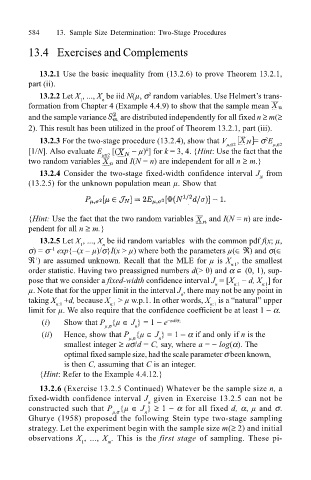Page 607 - Probability and Statistical Inference
P. 607
584 13. Sample Size Determination: Two-Stage Procedures
13.4 Exercises and Complements
13.2.1 Use the basic inequality from (13.2.6) to prove Theorem 13.2.1,
part (ii).
13.2.2 Let X , ..., X be iid N(µ, σ random variables. Use Helmerts trans-
2
1 n
formation from Chapter 4 (Example 4.4.9) to show that the sample mean
and the sample variance are distributed independently for all fixed n ≥ m(≥
2). This result has been utilized in the proof of Theorem 13.2.1, part (iii).
13.2.3 For the two-stage procedure (13.2.4), show that V µ,σ2 = σ E µ,σ2
2
[1/N]. Also evaluate E [( − µ) ] for k = 3, 4. {Hint: Use the fact that the
k
µσ2
two random variables and I(N = n) are independent for all n ≥ m.}
13.2.4 Consider the two-stage fixed-width confidence interval J from
N
(13.2.5) for the unknown population mean µ. Show that
{Hint: Use the fact that the two random variables and I(N = n) are inde-
pendent for all n ≥ m.}
13.2.5 Let X , ..., X be iid random variables with the common pdf f(x; µ,
n
1
σ) = σ exp{−(x − µ)/σ}I(x > µ) where both the parameters µ(∈ ℜ) and σ(∈
−1
ℜ ) are assumed unknown. Recall that the MLE for µ is X , the smallest
+
n:1
order statistic. Having two preassigned numbers d(> 0) and α ∈ (0, 1), sup-
pose that we consider a fixed-width confidence interval J = [X − d, X ] for
n:1
n:1
n
µ. Note that for the upper limit in the interval J , there may not be any point in
n
taking X +d, because X > µ w.p.1. In other words, X is a natural upper
n:1
n:1
n:1
limit for µ. We also require that the confidence coefficient be at least 1 − α.
(i) Show that P {µ ∈ J } = 1 − e −nd/σ;
µ,σ
n
(ii) Hence, show that P {µ ∈ J } = 1 − α if and only if n is the
µ,σ
n
smallest integer ≥ aσ/d = C, say, where a = − log(α). The
optimal fixed sample size, had the scale parameter σ been known,
is then C, assuming that C is an integer.
{Hint: Refer to the Example 4.4.12.}
13.2.6 (Exercise 13.2.5 Continued) Whatever be the sample size n, a
fixed-width confidence interval J given in Exercise 13.2.5 can not be
n
constructed such that P {µ ∈ J } ≥ 1 − α for all fixed d, α, µ and σ.
µ,σ
n
Ghurye (1958) proposed the following Stein type two-stage sampling
strategy. Let the experiment begin with the sample size m(≥ 2) and initial
observations X , ..., X . This is the first stage of sampling. These pi-
1 m

